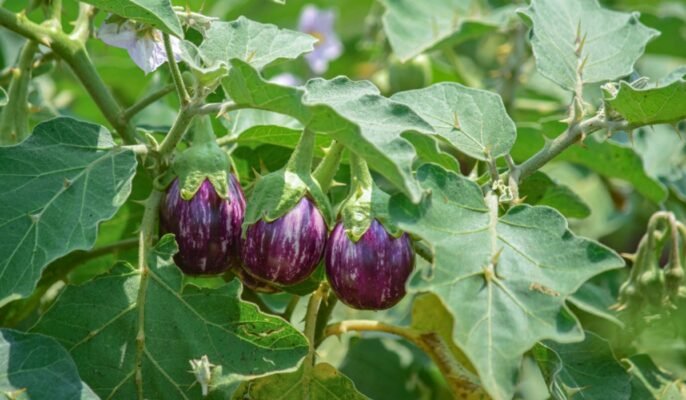Eggplant (in the United States, Canada, and Australia), Aubergine (in the United Kingdom and Ireland) or Brinjal (in the Indian subcontinent, Singapore, Malaysia, and South Africa) is a plant species in the nightshade family Solanaceae. Solanum melongena is cultivated for its edible fruit all over the world.
A variety of cuisines use the spongy, absorbent fruit, which is most frequently purple. It is a berry that is frequently used as a vegetable in cooking, according to botanical definition. It is related to the tomato, chilli pepper, and potato as a member of the genus Solanum, but those are from the new world, whereas the eggplant is from the old world. Its skin and seeds, like the tomato’s, can be eaten, but, like the potato, it is usually eaten cooked.
Eggplant is low in macronutrients and micronutrients, but its ability to absorb oils and flavours into its flesh through cooking expands its use in the culinary arts.
Source: Pinterest
Brinjal plant: Key facts
| Scientific Name | Solanum melongena |
| Family Name | Solanaceae |
| Common name | Brinjal, eggplant, aubergine |
| Height | 1-4 feet tall |
| Binomial name | Solanum melongena |
| Distribution Range | Europe, North America, Southeast Asia |
| Uses | Brinjal plants contain phenols, which may aid in the maintenance of blood glucose and blood pressure levels |
| Environmental Impact | Positive |
| Maintenance | Low |
| Best time to grow | Summer |
See also: al about Mushroom Seeds
Brinjal plant: Varieties
Casper
Many white-skinned brinjal plant varieties are grown, particularly in Southeast Asia. ‘Casper,’ an elongated white variety that matures fairly early and has a mild, almost mushroom-like flavour, is widely available in North America. The fruits of this cultivar, which was developed in France, ripen in about 60 days. White hybrids such as ‘Easter Egg’ are also commonly available in seed catalogues.
Hansel
‘Hansel’ belongs to the Asian brinjal plant family, which has smaller fruits that ripen quickly. This variety, a 2008 All-America Selections winner, has finger-length fruits with very little seed that grow in clusters. Because the plant is compact enough to be grown in containers, it can be started early. It can be harvested after 55 days when the fruits are 3 inches long or allowed to mature to 10-inch fruits. ‘Ping Tung Long,’ ‘Thai Long Green,’ ‘Louisiana Long Green,’ and ‘Green Banana’ are some similar varieties to consider.
Machiaw
‘Machiaw’ belongs to the Japanese brinjal plant group, which some experts include in the Asian brinjal plant group. These plants produce thin-skinned, slender fruits with few seeds. ‘Machiaw’ is a hybrid with 10-12-inch-long fruits that range in colour from pale purple to deep pink. In 60-70 days, the fruits are ready for harvest.
Rosa Bianca
The plump white-and-lavender-streaked fruit, ‘Rosa bianca,’ has become something of a poster vegetable for the heirloom gardener, but it’s difficult to grow in cooler climates. This cultivar is an Italian heirloom variety with 5-inch-long fruits that are known for their incredibly delicate, non-bitter flavour. A longer growing season of 70-80 days is required.
Calliope
Asia, Europe, and even Africa, all of which have a longer history with brinjal plants than the United States, have given us some of the best varieties. ‘Calliope,’ a white-and-purple-streaked type that is small, oval, and spineless, is one example. Despite being an Indian-style brinjal plant, ‘Calliope’ grows well in cooler climates and is flavorful when picked young (2 inches) or fully mature (3–4 inches).
Twinkle
If you prefer the traditional pear-shaped brinjal plant and your garden is on the cool side, try ‘Twinkle.’ This brinjal plant variety grows even smaller than ‘Hansel,’ reaching only about 2 feet in height. The oval fruits, which mature in 55-65 days and measure 2-2.5 inches long, are a deep plum with cream and are best harvested when immature. This is yet another plant with no spine.
Kermit
Growing and utilising dozens of varieties India and much of Southeast Asia has made the brinjal plant a standout in their cuisines. ‘Kermit’ is a cross between a Thai round brinjal plant and a hybrid. It bears small round fruits that are about 1.5 inches in diameter and have green skin with white swirls. Fruits can be harvested in about 60 days and eaten fresh or cooked.
Turkish orange
While the species S. melongene has a wide range of brinjal plants, some of the more unusual varieties fall under the tomato-fruited species S. integrifolium (sometimes classified as S. aethipicum). These plants with red and orange fruits, also known as Ethiopian brinjal plants, are widely grown in Asia and Africa. Many modern hybrids are descended from this species, including ‘Turkish orange,’ which produces 2-inch fruits that are excellent in curries. It matures in around 75 days.
Source: Pinterest
Brinjal plant: How to grow?
You have planted the seeds in the soil, but what happens once the brinjal plant begins to grow or is very young?
Here are some pointers to help you grow the best brinjal plant possible.
- Pour water into the soil at a depth of 6 inches on a regular basis to keep it moist. Overwatering the plant can cause root damage. Always use a hose with a dripping system to water your plants.
- When the fruits are about to develop, moisture is most critical. Due to insufficient water, odd-shaped brinjals will not develop, so make sure to add enough water.
- Mulch helps to maintain ideal moisture levels and inhibits weed growth. Furthermore, it aids in water conservation.
- It requires nutrient-rich soil, so apply fertiliser every two weeks. Excess nitrogen can have a negative impact on plant growth. Use a drip irrigation system to apply the fertilisers.
- You can limit larger plants to 5-6 fruits per plant or only fruits. Remove any extra flowers that may appear on the plant.
- The plant is fragile and may fall if the fruit load is heavy. As a result, ensure that you have a stake café that can support the growing plant. If you planted this plant in a container, stake all of the stems before it begins to produce fruits.
- Pinch out all of the bushier plant’s terminal growing flowers as well as the central points from which new shoots are emerging. Pinch out any new buds or leaves that appear on the plant.
- The plant is extremely sensitive to temperature fluctuations, such as hot days above 95°F/35°C and cool nights below 55°F/13°C. It may result in poor-quality fruits.
- To protect your plant, cover it during cold nights and provide adequate shelter during hot sunny days.
These are some of the best brinjal plant growing tips for your home garden. Having these ensures that you have brinjals in your plant that you can harvest during the season.
Brinjal plant: Care tips
- Brinjal plants require at least a five-month growing season and can be perennial in frost-free areas, cropping for several seasons.
- They require rich, well-drained soil. They can be grown directly from seed, but because they take a long time to fruit, you can speed up the process by growing them in trays four weeks before planting time and then planting the seeds when the ground warms up.
- It takes about 2-3 weeks for seeds to germinate. Seedlings should be spaced 45-60 cm apart or 1.5 to 2 ft apart.
- Take extreme caution when transplanting because it may disrupt plant growth. After 3-4 months, the plant will bear fruit.
- Brinjal plants are compact, self-supporting shrubs that grow 40-90 cm tall; however, heavier varieties may require support.
Source: Pinterest
Brinjal plant: Pest and diseases
Common pests like aphids, beetles and spider mites can hinder the growth of the brinjal plant. Regular inspection to detect and remove eggs and pests by hand is essential to prevent their damage. Another common issue is bacterial rot, which can be avoided through crop rotation and ensuring the soil receives adequate oxygenation. Taking these preventive measures will promote the healthy growth of brinjal plants.
Brinjal plant: Uses
- Brinjal appears to reduce the damage caused by free radicals, which may help to lower the risk of many heart diseases such as heart attack and stroke.
- Its essential components, such as bioactive compounds, potassium, fibre, and vitamin B6, may aid in heart blood circulation.
- Brinjal contains a variety of essential minerals, including copper, manganese, potassium, and magnesium, which may benefit bone health.
- Brinjal has been linked to improved brain health.
- Brinjal also contains essential plant nutrients that may help improve memory and protect brain cells.
How to store brinjal?
Eggplants can be stored in humid conditions at temperatures above 50°F (10°C) for up to 2 weeks. In the refrigerator, they will stay fresh for several days. Avoid washing or cutting them in advance to prevent damage to the skin, which can spoil quickly when exposed. When preparing eggplant for cooking or grilling, prevent discoloration by using a marinade with salt, vinegar, and/or lemon juice. This will help maintain the appearance and quality of the eggplant.
FAQs
How long will it take for a brinjal plant to mature?
It will take approximately 120-130 days from the time of seeding. It will, however, depend on the type of variety you have grown, but this is typically the range.
Do brinjal plants bear fruit all year?
No, it will perish as soon as it produces brinjals. You must replant the seeds for the following harvesting season.
Can we eat brinjal raw?
No, eating raw brinjal is not recommended. Brinjal contains a compound called solanine, which can cause neurological and gastrointestinal poisoning in large amounts.
Housing News Desk is the news desk of leading online real estate portal, Housing.com. Housing News Desk focuses on a variety of topics such as real estate laws, taxes, current news, property trends, home loans, rentals, décor, green homes, home improvement, etc. The main objective of the news desk, is to cover the real estate sector from the perspective of providing information that is useful to the end-user.
Facebook: https://www.facebook.com/housing.com/
Twitter: https://twitter.com/Housing
Email: editor@housing.com

